HRM 1: Workplace Diversity Report - Challenges and Opportunities
VerifiedAdded on 2022/09/25
|7
|1873
|21
Report
AI Summary
This report analyzes the opportunities and challenges of workplace diversity within the context of Human Resource Management (HRM). It begins by highlighting the increasing importance of diversity in modern organizations, emphasizing its ethical and strategic benefits. The report explores the advantages of diversity, such as new perspectives, increased innovation, a wider talent pool, and potential profit increment. It then delves into specific aspects of diversity, including gender and sexual orientation, examining leadership styles, gender stereotypes, and discrimination against LGBT individuals. The report also discusses the importance of justice and fairness in diversity management. Finally, the report addresses challenges, such as aligning diversity practices with organizational goals, providing adequate training, and managing internal resistance to change. It draws upon several academic sources to support its claims.
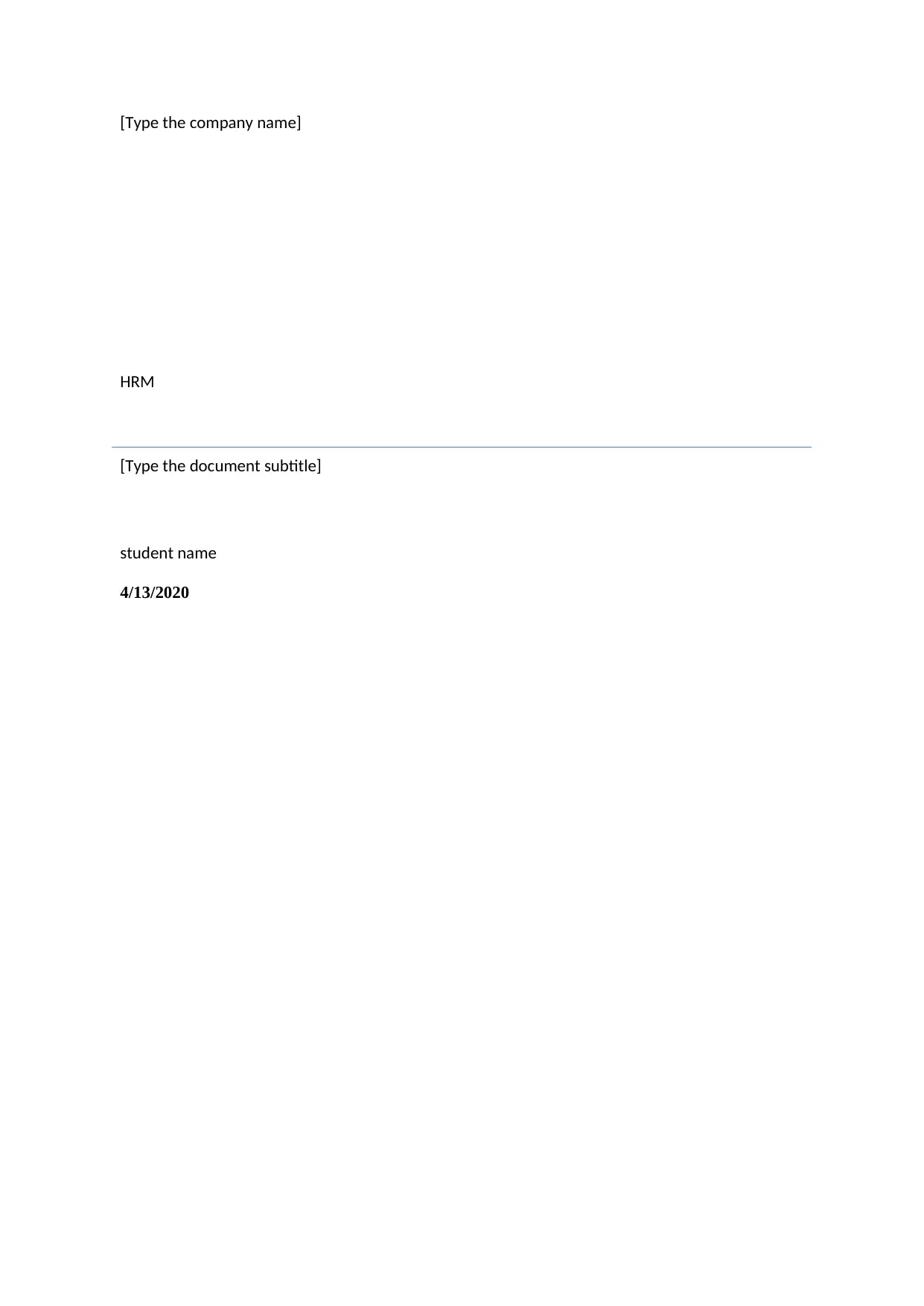
[Type the company name]
HRM
[Type the document subtitle]
student name
4/13/2020
HRM
[Type the document subtitle]
student name
4/13/2020
Paraphrase This Document
Need a fresh take? Get an instant paraphrase of this document with our AI Paraphraser
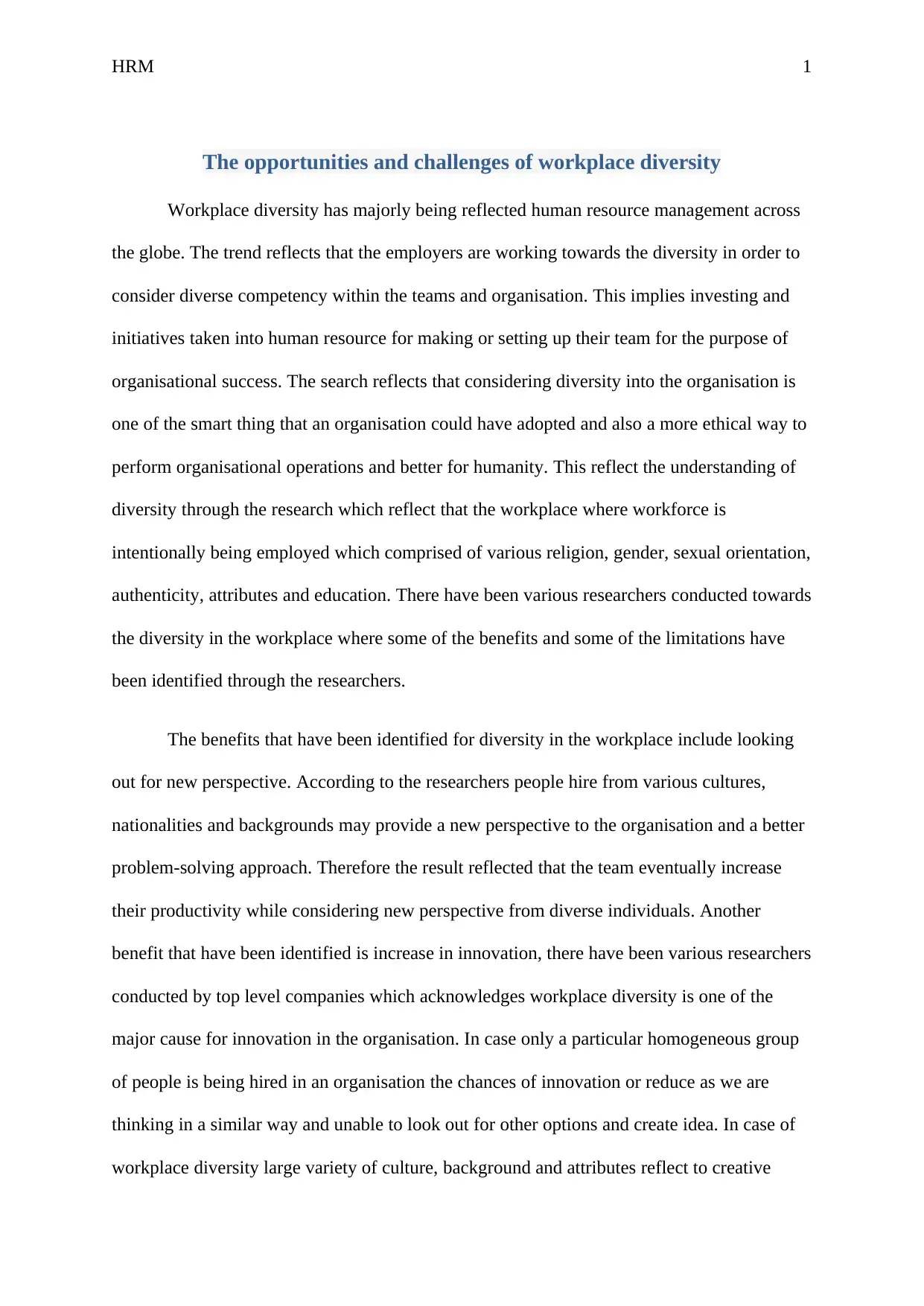
HRM 1
The opportunities and challenges of workplace diversity
Workplace diversity has majorly being reflected human resource management across
the globe. The trend reflects that the employers are working towards the diversity in order to
consider diverse competency within the teams and organisation. This implies investing and
initiatives taken into human resource for making or setting up their team for the purpose of
organisational success. The search reflects that considering diversity into the organisation is
one of the smart thing that an organisation could have adopted and also a more ethical way to
perform organisational operations and better for humanity. This reflect the understanding of
diversity through the research which reflect that the workplace where workforce is
intentionally being employed which comprised of various religion, gender, sexual orientation,
authenticity, attributes and education. There have been various researchers conducted towards
the diversity in the workplace where some of the benefits and some of the limitations have
been identified through the researchers.
The benefits that have been identified for diversity in the workplace include looking
out for new perspective. According to the researchers people hire from various cultures,
nationalities and backgrounds may provide a new perspective to the organisation and a better
problem-solving approach. Therefore the result reflected that the team eventually increase
their productivity while considering new perspective from diverse individuals. Another
benefit that have been identified is increase in innovation, there have been various researchers
conducted by top level companies which acknowledges workplace diversity is one of the
major cause for innovation in the organisation. In case only a particular homogeneous group
of people is being hired in an organisation the chances of innovation or reduce as we are
thinking in a similar way and unable to look out for other options and create idea. In case of
workplace diversity large variety of culture, background and attributes reflect to creative
The opportunities and challenges of workplace diversity
Workplace diversity has majorly being reflected human resource management across
the globe. The trend reflects that the employers are working towards the diversity in order to
consider diverse competency within the teams and organisation. This implies investing and
initiatives taken into human resource for making or setting up their team for the purpose of
organisational success. The search reflects that considering diversity into the organisation is
one of the smart thing that an organisation could have adopted and also a more ethical way to
perform organisational operations and better for humanity. This reflect the understanding of
diversity through the research which reflect that the workplace where workforce is
intentionally being employed which comprised of various religion, gender, sexual orientation,
authenticity, attributes and education. There have been various researchers conducted towards
the diversity in the workplace where some of the benefits and some of the limitations have
been identified through the researchers.
The benefits that have been identified for diversity in the workplace include looking
out for new perspective. According to the researchers people hire from various cultures,
nationalities and backgrounds may provide a new perspective to the organisation and a better
problem-solving approach. Therefore the result reflected that the team eventually increase
their productivity while considering new perspective from diverse individuals. Another
benefit that have been identified is increase in innovation, there have been various researchers
conducted by top level companies which acknowledges workplace diversity is one of the
major cause for innovation in the organisation. In case only a particular homogeneous group
of people is being hired in an organisation the chances of innovation or reduce as we are
thinking in a similar way and unable to look out for other options and create idea. In case of
workplace diversity large variety of culture, background and attributes reflect to creative
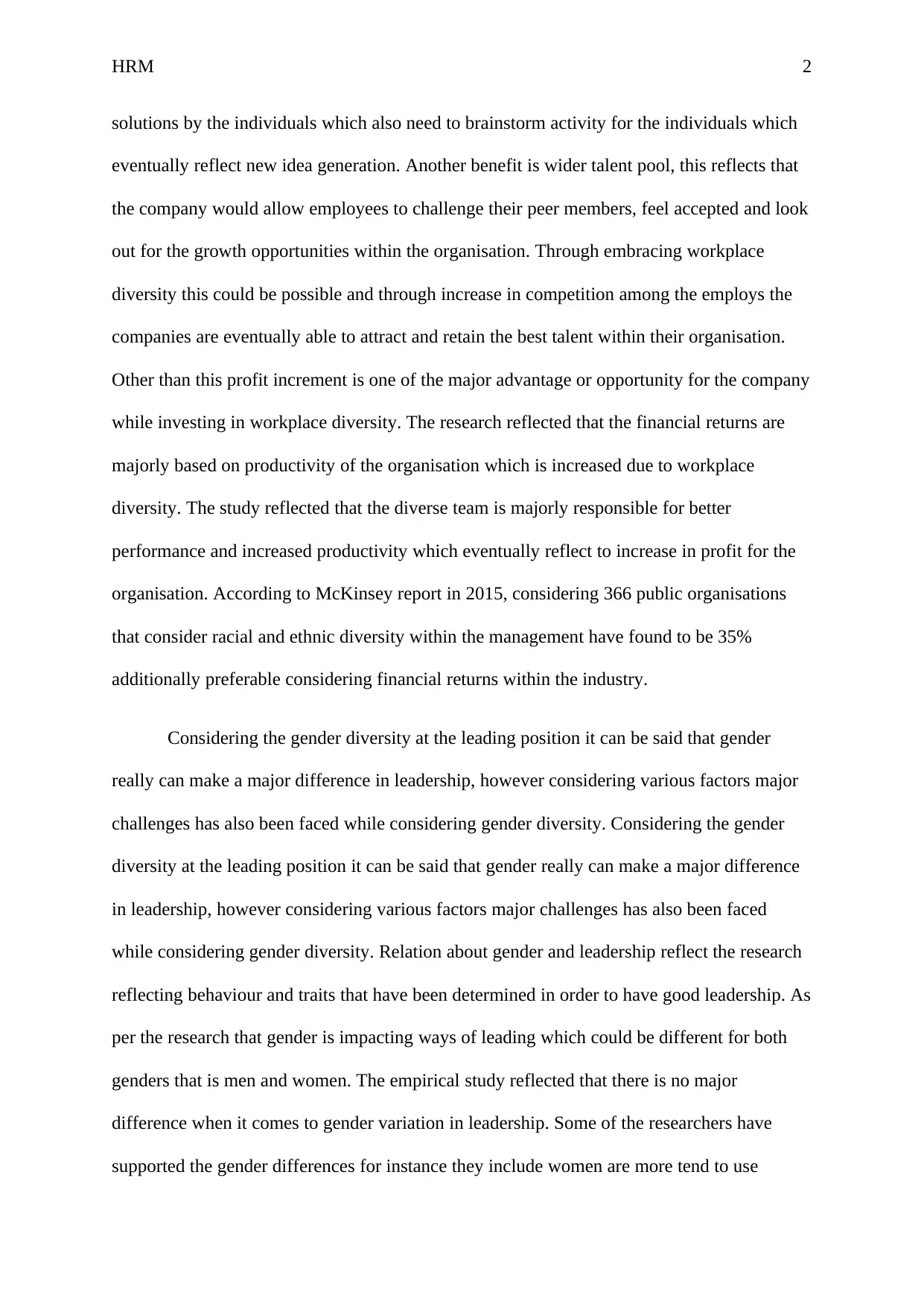
HRM 2
solutions by the individuals which also need to brainstorm activity for the individuals which
eventually reflect new idea generation. Another benefit is wider talent pool, this reflects that
the company would allow employees to challenge their peer members, feel accepted and look
out for the growth opportunities within the organisation. Through embracing workplace
diversity this could be possible and through increase in competition among the employs the
companies are eventually able to attract and retain the best talent within their organisation.
Other than this profit increment is one of the major advantage or opportunity for the company
while investing in workplace diversity. The research reflected that the financial returns are
majorly based on productivity of the organisation which is increased due to workplace
diversity. The study reflected that the diverse team is majorly responsible for better
performance and increased productivity which eventually reflect to increase in profit for the
organisation. According to McKinsey report in 2015, considering 366 public organisations
that consider racial and ethnic diversity within the management have found to be 35%
additionally preferable considering financial returns within the industry.
Considering the gender diversity at the leading position it can be said that gender
really can make a major difference in leadership, however considering various factors major
challenges has also been faced while considering gender diversity. Considering the gender
diversity at the leading position it can be said that gender really can make a major difference
in leadership, however considering various factors major challenges has also been faced
while considering gender diversity. Relation about gender and leadership reflect the research
reflecting behaviour and traits that have been determined in order to have good leadership. As
per the research that gender is impacting ways of leading which could be different for both
genders that is men and women. The empirical study reflected that there is no major
difference when it comes to gender variation in leadership. Some of the researchers have
supported the gender differences for instance they include women are more tend to use
solutions by the individuals which also need to brainstorm activity for the individuals which
eventually reflect new idea generation. Another benefit is wider talent pool, this reflects that
the company would allow employees to challenge their peer members, feel accepted and look
out for the growth opportunities within the organisation. Through embracing workplace
diversity this could be possible and through increase in competition among the employs the
companies are eventually able to attract and retain the best talent within their organisation.
Other than this profit increment is one of the major advantage or opportunity for the company
while investing in workplace diversity. The research reflected that the financial returns are
majorly based on productivity of the organisation which is increased due to workplace
diversity. The study reflected that the diverse team is majorly responsible for better
performance and increased productivity which eventually reflect to increase in profit for the
organisation. According to McKinsey report in 2015, considering 366 public organisations
that consider racial and ethnic diversity within the management have found to be 35%
additionally preferable considering financial returns within the industry.
Considering the gender diversity at the leading position it can be said that gender
really can make a major difference in leadership, however considering various factors major
challenges has also been faced while considering gender diversity. Considering the gender
diversity at the leading position it can be said that gender really can make a major difference
in leadership, however considering various factors major challenges has also been faced
while considering gender diversity. Relation about gender and leadership reflect the research
reflecting behaviour and traits that have been determined in order to have good leadership. As
per the research that gender is impacting ways of leading which could be different for both
genders that is men and women. The empirical study reflected that there is no major
difference when it comes to gender variation in leadership. Some of the researchers have
supported the gender differences for instance they include women are more tend to use
⊘ This is a preview!⊘
Do you want full access?
Subscribe today to unlock all pages.

Trusted by 1+ million students worldwide
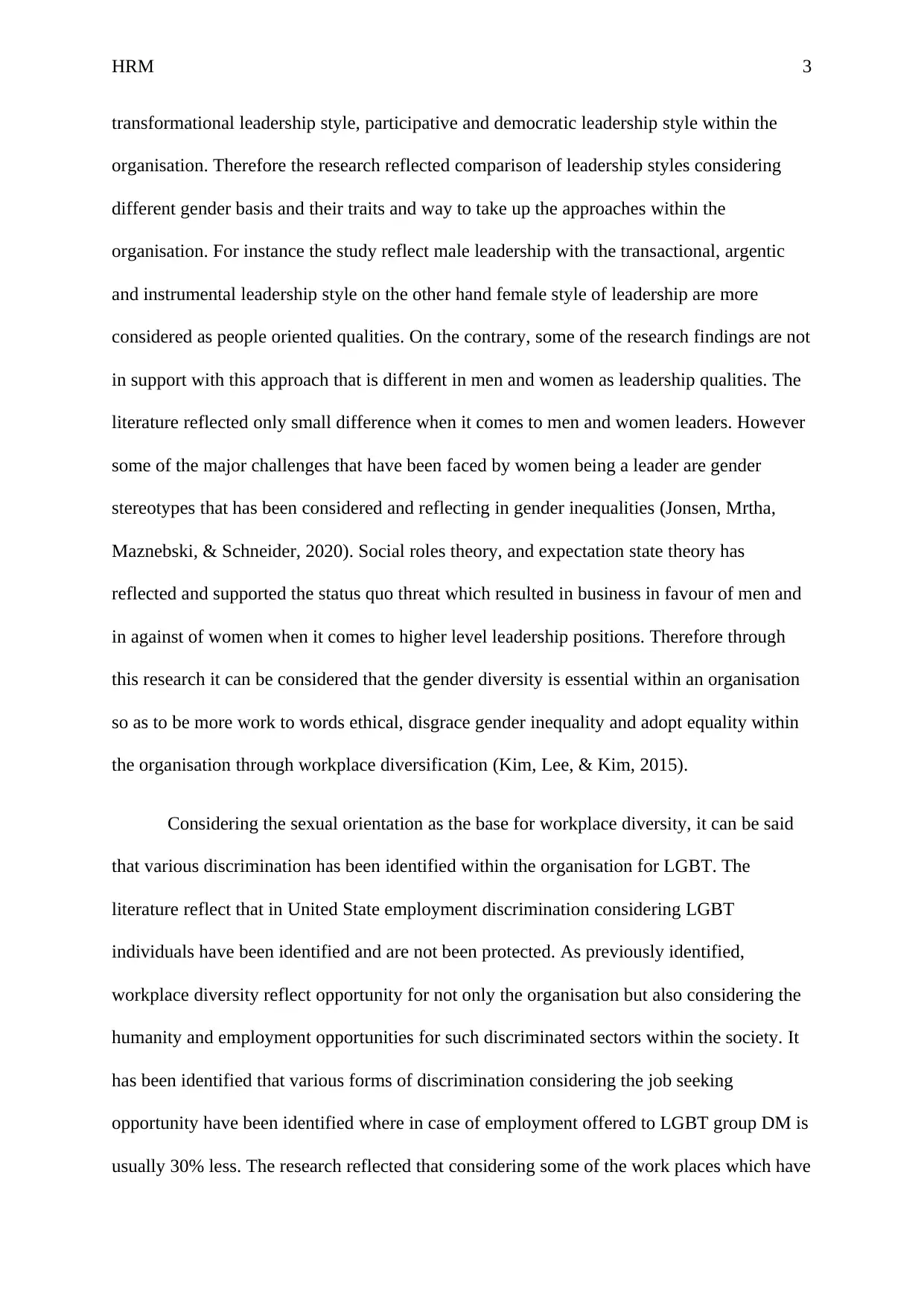
HRM 3
transformational leadership style, participative and democratic leadership style within the
organisation. Therefore the research reflected comparison of leadership styles considering
different gender basis and their traits and way to take up the approaches within the
organisation. For instance the study reflect male leadership with the transactional, argentic
and instrumental leadership style on the other hand female style of leadership are more
considered as people oriented qualities. On the contrary, some of the research findings are not
in support with this approach that is different in men and women as leadership qualities. The
literature reflected only small difference when it comes to men and women leaders. However
some of the major challenges that have been faced by women being a leader are gender
stereotypes that has been considered and reflecting in gender inequalities (Jonsen, Mrtha,
Maznebski, & Schneider, 2020). Social roles theory, and expectation state theory has
reflected and supported the status quo threat which resulted in business in favour of men and
in against of women when it comes to higher level leadership positions. Therefore through
this research it can be considered that the gender diversity is essential within an organisation
so as to be more work to words ethical, disgrace gender inequality and adopt equality within
the organisation through workplace diversification (Kim, Lee, & Kim, 2015).
Considering the sexual orientation as the base for workplace diversity, it can be said
that various discrimination has been identified within the organisation for LGBT. The
literature reflect that in United State employment discrimination considering LGBT
individuals have been identified and are not been protected. As previously identified,
workplace diversity reflect opportunity for not only the organisation but also considering the
humanity and employment opportunities for such discriminated sectors within the society. It
has been identified that various forms of discrimination considering the job seeking
opportunity have been identified where in case of employment offered to LGBT group DM is
usually 30% less. The research reflected that considering some of the work places which have
transformational leadership style, participative and democratic leadership style within the
organisation. Therefore the research reflected comparison of leadership styles considering
different gender basis and their traits and way to take up the approaches within the
organisation. For instance the study reflect male leadership with the transactional, argentic
and instrumental leadership style on the other hand female style of leadership are more
considered as people oriented qualities. On the contrary, some of the research findings are not
in support with this approach that is different in men and women as leadership qualities. The
literature reflected only small difference when it comes to men and women leaders. However
some of the major challenges that have been faced by women being a leader are gender
stereotypes that has been considered and reflecting in gender inequalities (Jonsen, Mrtha,
Maznebski, & Schneider, 2020). Social roles theory, and expectation state theory has
reflected and supported the status quo threat which resulted in business in favour of men and
in against of women when it comes to higher level leadership positions. Therefore through
this research it can be considered that the gender diversity is essential within an organisation
so as to be more work to words ethical, disgrace gender inequality and adopt equality within
the organisation through workplace diversification (Kim, Lee, & Kim, 2015).
Considering the sexual orientation as the base for workplace diversity, it can be said
that various discrimination has been identified within the organisation for LGBT. The
literature reflect that in United State employment discrimination considering LGBT
individuals have been identified and are not been protected. As previously identified,
workplace diversity reflect opportunity for not only the organisation but also considering the
humanity and employment opportunities for such discriminated sectors within the society. It
has been identified that various forms of discrimination considering the job seeking
opportunity have been identified where in case of employment offered to LGBT group DM is
usually 30% less. The research reflected that considering some of the work places which have
Paraphrase This Document
Need a fresh take? Get an instant paraphrase of this document with our AI Paraphraser
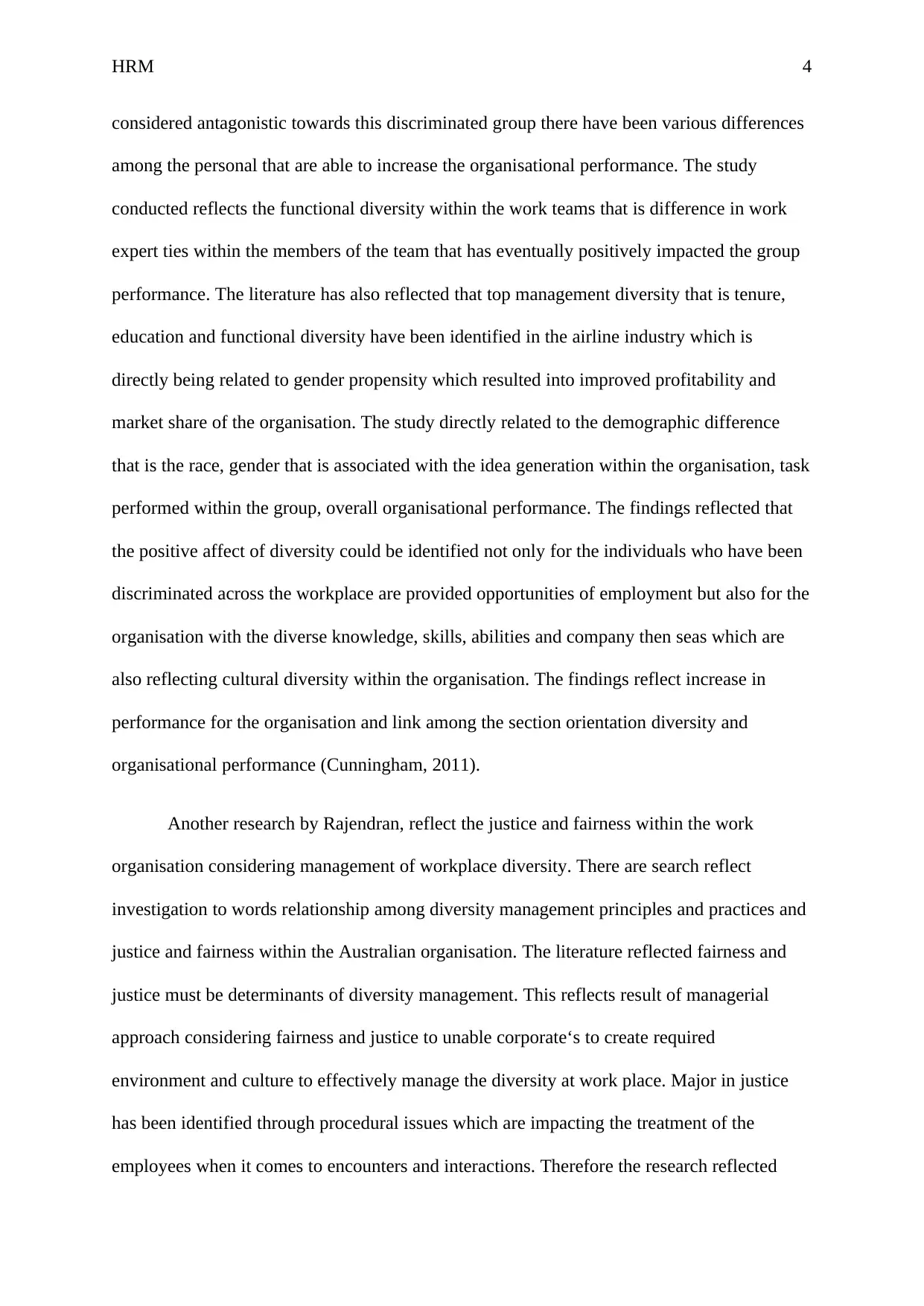
HRM 4
considered antagonistic towards this discriminated group there have been various differences
among the personal that are able to increase the organisational performance. The study
conducted reflects the functional diversity within the work teams that is difference in work
expert ties within the members of the team that has eventually positively impacted the group
performance. The literature has also reflected that top management diversity that is tenure,
education and functional diversity have been identified in the airline industry which is
directly being related to gender propensity which resulted into improved profitability and
market share of the organisation. The study directly related to the demographic difference
that is the race, gender that is associated with the idea generation within the organisation, task
performed within the group, overall organisational performance. The findings reflected that
the positive affect of diversity could be identified not only for the individuals who have been
discriminated across the workplace are provided opportunities of employment but also for the
organisation with the diverse knowledge, skills, abilities and company then seas which are
also reflecting cultural diversity within the organisation. The findings reflect increase in
performance for the organisation and link among the section orientation diversity and
organisational performance (Cunningham, 2011).
Another research by Rajendran, reflect the justice and fairness within the work
organisation considering management of workplace diversity. There are search reflect
investigation to words relationship among diversity management principles and practices and
justice and fairness within the Australian organisation. The literature reflected fairness and
justice must be determinants of diversity management. This reflects result of managerial
approach considering fairness and justice to unable corporate‘s to create required
environment and culture to effectively manage the diversity at work place. Major in justice
has been identified through procedural issues which are impacting the treatment of the
employees when it comes to encounters and interactions. Therefore the research reflected
considered antagonistic towards this discriminated group there have been various differences
among the personal that are able to increase the organisational performance. The study
conducted reflects the functional diversity within the work teams that is difference in work
expert ties within the members of the team that has eventually positively impacted the group
performance. The literature has also reflected that top management diversity that is tenure,
education and functional diversity have been identified in the airline industry which is
directly being related to gender propensity which resulted into improved profitability and
market share of the organisation. The study directly related to the demographic difference
that is the race, gender that is associated with the idea generation within the organisation, task
performed within the group, overall organisational performance. The findings reflected that
the positive affect of diversity could be identified not only for the individuals who have been
discriminated across the workplace are provided opportunities of employment but also for the
organisation with the diverse knowledge, skills, abilities and company then seas which are
also reflecting cultural diversity within the organisation. The findings reflect increase in
performance for the organisation and link among the section orientation diversity and
organisational performance (Cunningham, 2011).
Another research by Rajendran, reflect the justice and fairness within the work
organisation considering management of workplace diversity. There are search reflect
investigation to words relationship among diversity management principles and practices and
justice and fairness within the Australian organisation. The literature reflected fairness and
justice must be determinants of diversity management. This reflects result of managerial
approach considering fairness and justice to unable corporate‘s to create required
environment and culture to effectively manage the diversity at work place. Major in justice
has been identified through procedural issues which are impacting the treatment of the
employees when it comes to encounters and interactions. Therefore the research reflected
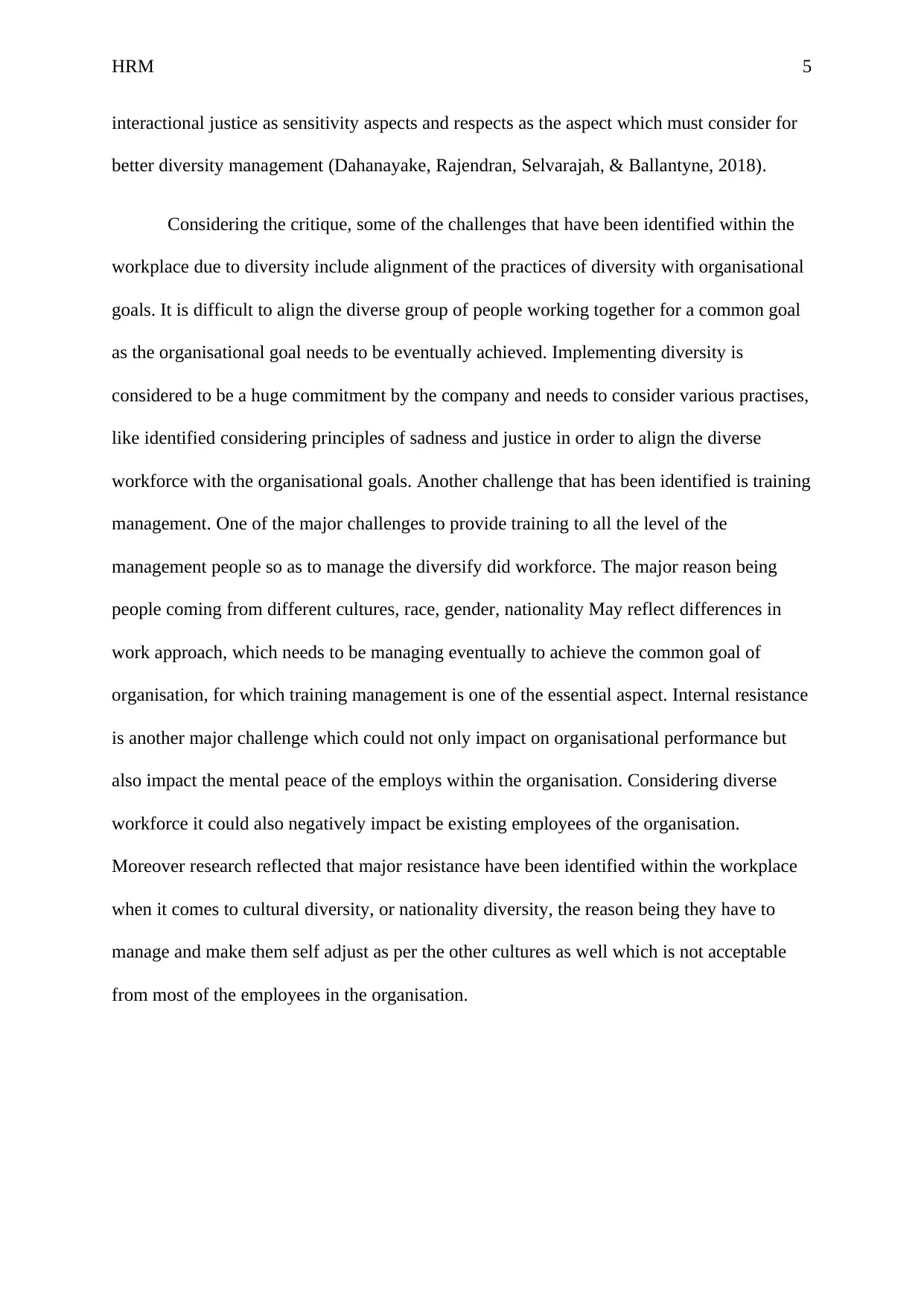
HRM 5
interactional justice as sensitivity aspects and respects as the aspect which must consider for
better diversity management (Dahanayake, Rajendran, Selvarajah, & Ballantyne, 2018).
Considering the critique, some of the challenges that have been identified within the
workplace due to diversity include alignment of the practices of diversity with organisational
goals. It is difficult to align the diverse group of people working together for a common goal
as the organisational goal needs to be eventually achieved. Implementing diversity is
considered to be a huge commitment by the company and needs to consider various practises,
like identified considering principles of sadness and justice in order to align the diverse
workforce with the organisational goals. Another challenge that has been identified is training
management. One of the major challenges to provide training to all the level of the
management people so as to manage the diversify did workforce. The major reason being
people coming from different cultures, race, gender, nationality May reflect differences in
work approach, which needs to be managing eventually to achieve the common goal of
organisation, for which training management is one of the essential aspect. Internal resistance
is another major challenge which could not only impact on organisational performance but
also impact the mental peace of the employs within the organisation. Considering diverse
workforce it could also negatively impact be existing employees of the organisation.
Moreover research reflected that major resistance have been identified within the workplace
when it comes to cultural diversity, or nationality diversity, the reason being they have to
manage and make them self adjust as per the other cultures as well which is not acceptable
from most of the employees in the organisation.
interactional justice as sensitivity aspects and respects as the aspect which must consider for
better diversity management (Dahanayake, Rajendran, Selvarajah, & Ballantyne, 2018).
Considering the critique, some of the challenges that have been identified within the
workplace due to diversity include alignment of the practices of diversity with organisational
goals. It is difficult to align the diverse group of people working together for a common goal
as the organisational goal needs to be eventually achieved. Implementing diversity is
considered to be a huge commitment by the company and needs to consider various practises,
like identified considering principles of sadness and justice in order to align the diverse
workforce with the organisational goals. Another challenge that has been identified is training
management. One of the major challenges to provide training to all the level of the
management people so as to manage the diversify did workforce. The major reason being
people coming from different cultures, race, gender, nationality May reflect differences in
work approach, which needs to be managing eventually to achieve the common goal of
organisation, for which training management is one of the essential aspect. Internal resistance
is another major challenge which could not only impact on organisational performance but
also impact the mental peace of the employs within the organisation. Considering diverse
workforce it could also negatively impact be existing employees of the organisation.
Moreover research reflected that major resistance have been identified within the workplace
when it comes to cultural diversity, or nationality diversity, the reason being they have to
manage and make them self adjust as per the other cultures as well which is not acceptable
from most of the employees in the organisation.
⊘ This is a preview!⊘
Do you want full access?
Subscribe today to unlock all pages.

Trusted by 1+ million students worldwide
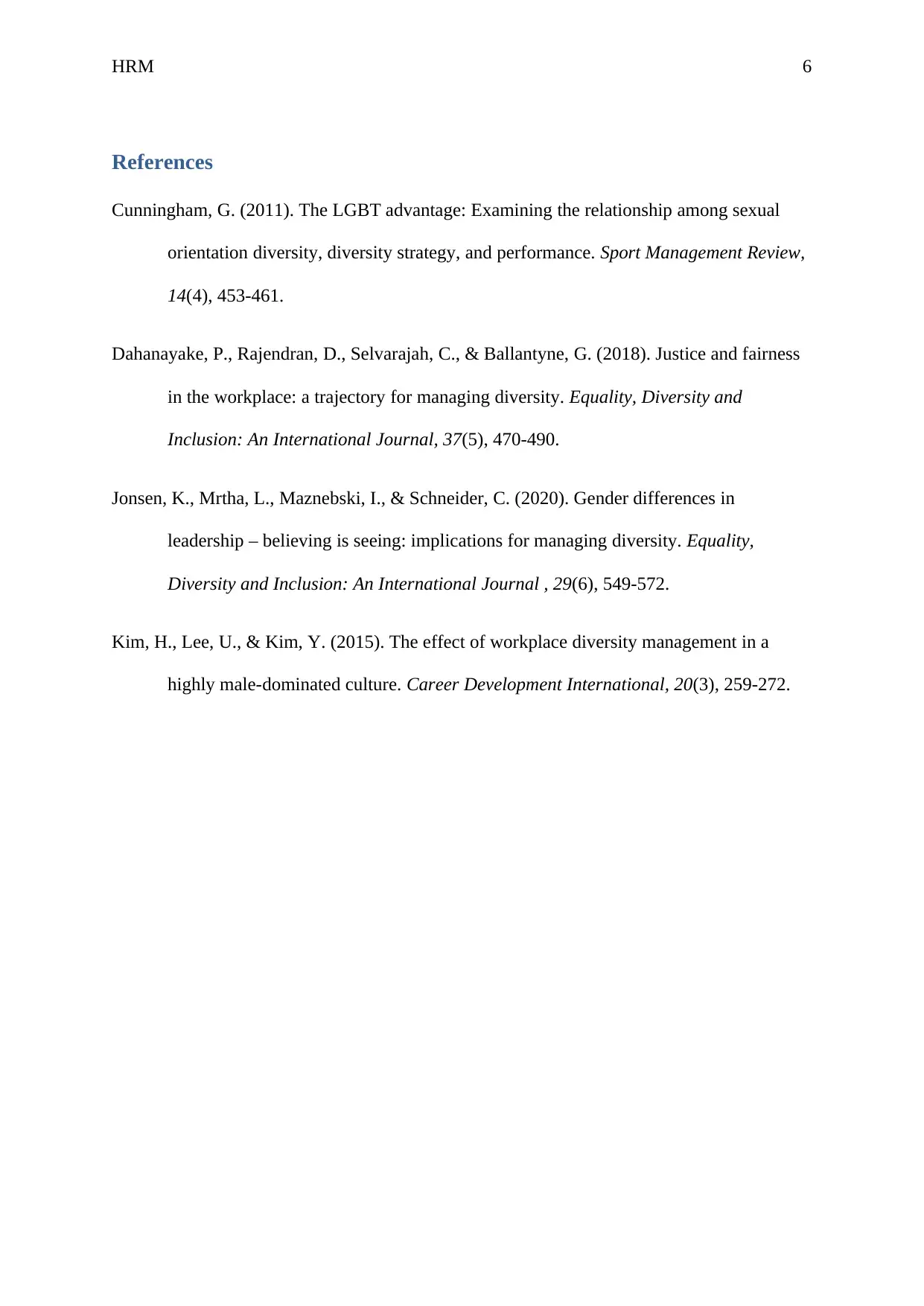
HRM 6
References
Cunningham, G. (2011). The LGBT advantage: Examining the relationship among sexual
orientation diversity, diversity strategy, and performance. Sport Management Review,
14(4), 453-461.
Dahanayake, P., Rajendran, D., Selvarajah, C., & Ballantyne, G. (2018). Justice and fairness
in the workplace: a trajectory for managing diversity. Equality, Diversity and
Inclusion: An International Journal, 37(5), 470-490.
Jonsen, K., Mrtha, L., Maznebski, I., & Schneider, C. (2020). Gender differences in
leadership – believing is seeing: implications for managing diversity. Equality,
Diversity and Inclusion: An International Journal , 29(6), 549-572.
Kim, H., Lee, U., & Kim, Y. (2015). The effect of workplace diversity management in a
highly male-dominated culture. Career Development International, 20(3), 259-272.
References
Cunningham, G. (2011). The LGBT advantage: Examining the relationship among sexual
orientation diversity, diversity strategy, and performance. Sport Management Review,
14(4), 453-461.
Dahanayake, P., Rajendran, D., Selvarajah, C., & Ballantyne, G. (2018). Justice and fairness
in the workplace: a trajectory for managing diversity. Equality, Diversity and
Inclusion: An International Journal, 37(5), 470-490.
Jonsen, K., Mrtha, L., Maznebski, I., & Schneider, C. (2020). Gender differences in
leadership – believing is seeing: implications for managing diversity. Equality,
Diversity and Inclusion: An International Journal , 29(6), 549-572.
Kim, H., Lee, U., & Kim, Y. (2015). The effect of workplace diversity management in a
highly male-dominated culture. Career Development International, 20(3), 259-272.
1 out of 7
Related Documents
Your All-in-One AI-Powered Toolkit for Academic Success.
+13062052269
info@desklib.com
Available 24*7 on WhatsApp / Email
![[object Object]](/_next/static/media/star-bottom.7253800d.svg)
Unlock your academic potential
Copyright © 2020–2025 A2Z Services. All Rights Reserved. Developed and managed by ZUCOL.





